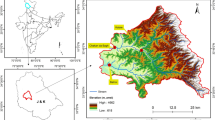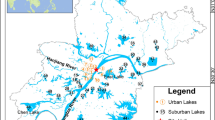Abstract
Thermal structure and water quality in a large and shallow lake in Malaysia were studied between January 2012 and June 2013 in order to understand variations in relation to water level fluctuations and in-stream mining activities. Environmental variables, namely temperature, turbidity, dissolved oxygen, pH, electrical conductivity, chlorophyll-A and transparency, were measured using a multi-parameter probe and a Secchi disk. Measurements of environmental variables were performed at 0.1 m intervals from the surface to the bottom of the lake during the dry and wet seasons. High water level and strong solar radiation increased temperature stratification. River discharges during the wet season, and unsustainable sand mining activities led to an increased turbidity exceeding 100 NTU, and reduced transparency, which changed the temperature variation and subsequently altered the water quality pattern.






Similar content being viewed by others
References
Akademi Sains Malaysia. (2010). Managing lakes and their basins for sustainable use in Malaysia (Lake Briefs Report Series I). Kuala Lumpur: Akademi Sains Malaysia.
APHA. (1998). Standard methods for the examination of water and waste water. Washington, DC: American Public Health Association (APHA).
Aprile, F. M. (2011). Thermal structure of the Poraquê lake, Central Amazonian, Brazil. Acta Scientiarum. Biological Sciences, 33, 171–178.
Aprile, F., Darwich, A. J., Siqueira, G. W., Ribeiro, A. A., & Santos, V. C. (2013a). Hydrological characterization of a whitewater lake at Amazon floodplain-Brazil. International Research Journal of Environmental Sciences, 2, 44–53.
Aprile, F., Darwich, A. J., Siqueira, G. W., Santos, F. R. R., & Miguéis, A. M. B. (2013b). Application of hydrological and limnological studies on building model for water circulation of meromictic black water lakes at the Central Amazonia, Brazil. International Research Journal of Environmental Sciences, 2, 58–63.
Ashraf, M. A., Maah, M. J., Yusoff, I., Wajid, A., & Mahmood, K. (2011). Sand mining effects, causes and concerns: a case study from Bestari Jaya, Selangor, Peninsular Malaysia. Scientific Research and Essays, 6, 1216–1231.
Barbosa, F. A. R., & Tundisi, J. G. (1989). Diel variations in a shallow tropical Brazilian lake.1. The influence of temperature-variation on the distribution of dissolved-oxygen and nutrients. Archiv Fur Hydrobiologie, 116, 333–349.
Brown, A. V., Lyttle, M. M., & Brown, K. B. (1998). Impacts of gravel mining on gravel bed streams. Transactions of the American Fisheries Society, 127, 979–994.
DID. (2009). River sand mining management guidelines. Kuala Lumpur: Department of Irrigation and Drainage.
Hasan, Z.A., Yusoff, M.S. & Talib, S.H.A. (2011). Bukit Merah reservoir sedimentation assessment. In. International Conference on Environment Science and Engineering (pp. 86-90). Singapore: IACSIT Press.
Henry, R. (1995). The thermal structure of some lakes and reservoirs in Brazil. In J.G. Tundisi, C.E.M. Bicudo & T.M. Tundisi (Eds.) Limnology in Brazil (pp. 351-363). Rio de janeiro.
Hidzrami, S.A. (2010). Bukit Merah, Perak, Lake Brief. In. Managing lakes and their basins for sustainable use in Malaysia (Lake Briefs Report Series 1) (pp. 29-72). Kuala Lumpur: Akademi Sains Malaysia.
Imberger, J. (1985). Thermal characteristics of standing waters: an illustration of dynamic processes. Hydrobiologia, 125, 7–29.
Imberger, J., & Patterson, J. C. (1990). Physical Limnology. Advances in Applied Mechanics, 27, 303–475.
Ismail, W. R., & Najib, S. A. M. (2011). Sediment and nutrient balance of Bukit Merah Reservoir, Perak (Malaysia). Lakes & Reservoirs Research and Management, 16, 179–184.
Ismail, W.R., Rahaman, Z.A., Najib, S.A.M., & Othman, Z. (2010). Sediment impacts on aquatic ecosystems of the Bukit Merah Reservoir, Perak, Malaysia. In. Sediment Dynamics for a Changing Future. The Warsaw University of Life Sciences, SGGW, Poland: IAHS Publ.
Jacobs, A., Jetten, T., Lucassen, D., Heusinkveld, B., & Nieveen, J. (1997). Diurnal temperature fluctuations in a natural shallow water body. Agricultural and Forest Meteorology, 88, 269–277.
Kirk, J. (1983). Light and photosynthesis in aquatic ecosystems. Cambridge: Cambridge University Press.
Kondolf, G. M. (1994). Geomorphic and environmental effects of instream gravel mining. Landscape and Urban Planning, 28, 225–243.
Leeuw, J. D., Shankman, D., Wu, G., Boer, W. F. D., Burnham, J., He, Q., et al. (2009). Strategic assessment of the magnitude and impacts of sand mining in Poyang Lake, China. Regional Environmental Change, 10, 95–102.
Lewis, W. M. (1983). A revised classification of lakes based on mixing. Canadian Journal of Fisheries and Aquatic Sciences, 40, 1779–1787.
Lewis, W. M. (1987). Tropical limnology. Annual Review of Ecology and Systematics, 18, 159–184.
MacIntyre, S., & Melack, J. (1988). Frequency and depth of vertical mixing in an amazon floodplain lake (L. Calado, Brazil). Verhandlungen der Internationales Verein Limnologie, 23, 80–85.
Meador, M. R., & Layher, A. O. (1998). Instream sand and gravel mining: environmental issues and regulatory process in the United States. Fisheries, 23, 6–13.
Padmalal, D., Maya, K., Sreebha, S., & Sreeja, R. (2008). Environmental effects of river sand mining: a case from the river catchments of Vembanad lake, Southwest coast of India. Environmental Geology, 54, 879–889.
Rast, W. & Lee, G.F. (1978). Summary analysis of the North American Project (US Portion) OECD Eutrophication Project: Nutrient Loading - Lakes response relationships and trophic state indices. Report No. EPA-600/3-78-0, Ecological Research Series, US Environmental Protection Agency, Corvallis, Oregon, USA.
Scheffer, M. (2004). Ecology of shallow lakes. Dordrecht: Kluwer Academic Publishers.
Sharip, Z., Hipsey, M. R., Schooler, S. S., & Hobbs, R. J. (2012a). Physical circulation and spatial exchange dynamics in a shallow floodplain wetland. International Journal of Design & Nature and Ecodynamics, 7, 274–291.
Sharip, Z., Schooler, S. S., Hipsey, M. R., & Hobbs, R. J. (2012b). Eutrophication, agriculture and water level control shift aquatic plant communities from floating-leaved to submerged macrophytes in Lake Chini, Malaysia. Biological Invasions, 14, 1029–1044.
Sulaiman, W. N., & Hamid, M. R. (1997). Suspended sediment and turbidity relationships for individual and multiple catchments. Pertanika Journal of Science and Technology, 5, 127–137.
Tundisi, J. G., Forsberg, B. R., Devol, A. H., Zaret, T. M., Tundisi, T. M., Santos, A. D., et al. (1984). Mixing patterns in Amazon lakes. Hydrobiologia, 108, 3–15.
Yen, T. P., & Rohasliney, H. (2013). Status of water quality subject to sand mining in the Kelantan River, Kelantan. Tropical Life Sciences Research, 24, 19–34.
Yusoff, F. M., Ambak, M. A., & Mohsin, A. K. M. (1982). Diurnal fluctuations of some physico-chemical parameters in a swamp lake in Malaysia. Malaysian Applied Biology, 11, 75–83.
Acknowledgements
The authors would like to thank Ir. Juhaimi Jusoh, Dr. Saim Suratman and Ir. Ahmad Jamalluddin Shaaban for their role and support in this project. Thanks to Kerian District Drainage and Irrigation Department for support to carry out this study in the Lake Bukit Merah.
Author information
Authors and Affiliations
Corresponding author
Rights and permissions
About this article
Cite this article
Sharip, Z., Zaki, A.T.A. The effects of season and sand mining activities on thermal regime and water quality in a large shallow tropical lake. Environ Monit Assess 186, 4959–4969 (2014). https://doi.org/10.1007/s10661-014-3751-4
Received:
Accepted:
Published:
Issue Date:
DOI: https://doi.org/10.1007/s10661-014-3751-4




